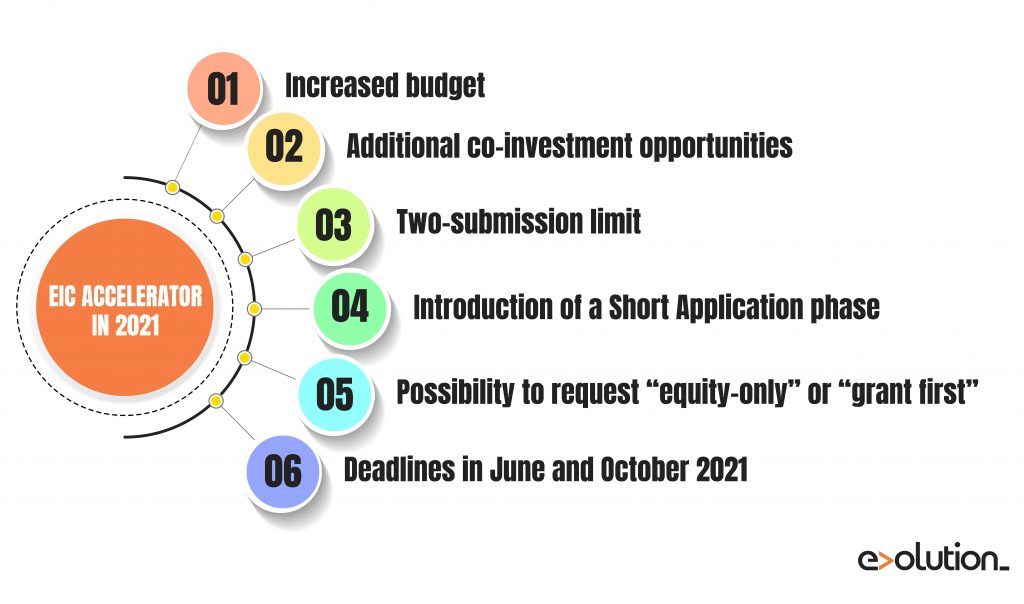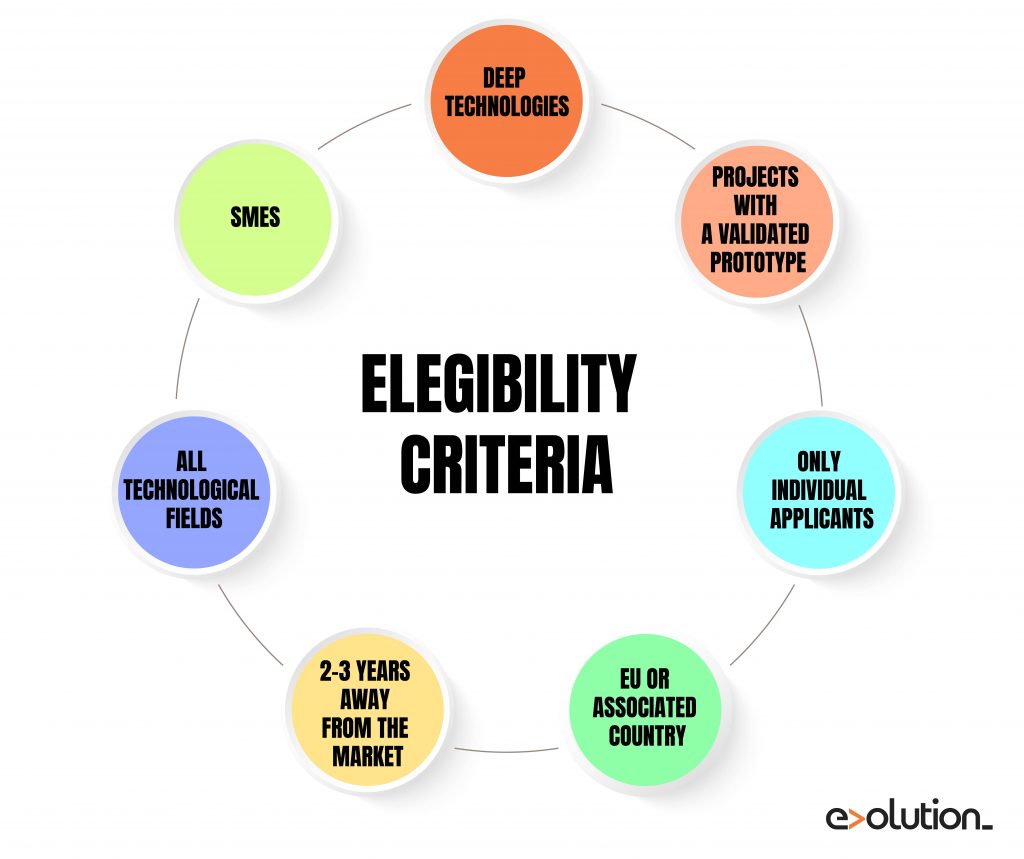The new EIC Accelerator Programme under Horizon Europe: Why should you apply in 2021?

Disclaimer: This post was written a time ago, so some details may have changed since then. We advise you to check out our services page for more information or to contact us directly through this form. Thanks!
If you are familiar with EU funding for R&D projects, we are sure it’s not the first time you have heard about the EIC Accelerator. As you may know, EIC Accelerator (previously known as SME Instrument) is a funding programme for start-ups and SMEs, created by the European Commission as a part of the European Innovation Council pilot.
Since its beginning, the EIC Accelerator has already boosted more than 5,400 innovative projects, allowing them to obtain funding of more than €2,869M, business coaching and the opportunity to commercialise in European and international markets. Thanks to its non-dilutive financing of up to €2.5M, EIC Accelerator covers 70% of the project’s eligible costs to reach the commercialisation stage.
Furthermore, from October 2019, this programme began to offer blended finance which includes an optional investment component in the form of equity funding of up to €15M. This equity funding can be used to cover the 30% of the non-grant funded part of the budget and rapid scale-up activities (TRL 9).
Although all technological fields are eligible, applying for the EIC Accelerator is a must for deep tech companies. For this company profile, alternative funding options are far and few between. A successful EIC Accelerator application would represent a significant turning point in their path to successfully reach the market.
If you think your technology deserves to be among the most innovative and high impact projects in Europe, 2021 could be the year to obtain EIC Accelerator funding for your company. Let us explain to you why.
EIC Accelerator in 2021: the most impactful changes you need to know
Although the European Commission hasn’t published the official Work Programme yet, we are sharing with you below the most important provisional changes.
These represent a commitment from the European Innovation Council to continuous improvement, hopefully resulting in a fairer and more worthwhile process for many R&d companies in 2021.
The updated EIC Accelerator would include the changes shared below:
- Increased budget: in 2020 the EIC Accelerator budget was between €176M and €314M cut-off to cut-off. In 2021, there will be €601M for the Open Calls and €507M for Challenge-Specific Calls, in part, thanks to more than €300M from the Next Generation Fund that has been earmarked for this purpose.
- Additional co-investment opportunities: The European Commission hopes to crowd-in further investment for EIC projects to maximise applicant companies’ access to funding.
- Two-submission limit: After two unsuccessful attempts, companies would have to go to a “freezer” which prohibits them from applying again for a minimum 12-month waiting period. This submission limit will reduce the “snowball effect” that plagued the programme under H2020. Over the medium-term, this will reduce the total volume of submissions in each cut-off and increase the average EU Success rate, making the programme much more attractive. It should also encourage companies to apply at the right developmental stage (TRL6) and implement thoughtful changes when reapplying.
- Introduction of a Short Application phase to pre-filter companies: The EIC Accelerator application process may also experience some changes. From now on, companies will have to pass a Short Application phase before they are allowed to submit a Full Application. This will enable companies to get initial feedback from the EU evaluators before doing the “heavy-lifting” and writing a full application.
- The updated EIC Accelerator would allow companies to request “equity-only” or “grant first”: making the programme more flexible and adaptable to your projects’ funding needs.
- It seems the European Commission will set two new deadlines to apply to this funding line this year. These two cut-offs would take place in June and October 2021.

Which projects would be ideal candidates for EIC Accelerator?
Conditions to succeed in EIC Accelerator are not black or white, but we have summarised some high-level requirements.
- Deep Technologies: this means technology based on scientific discoveries and advancements, not on gradual or progressive improvements.
- Projects with a validated prototype. In other words, with TRL 5 (Technology validated in a relevant environment) and TRL 6 (Technology demonstrated in a relevant environment).
- Only individual applicants would be able to benefit from this programme. This means that the applicant company can develop the technology’s core and be responsible for executing its commercialisation plan.
- It is also important to remember that these candidates must be established in a European or associated country.
- Projects that are two/three years away from the market and with ambitious scale-up potential are most attractive to the jury.
- As we previously said, projects related to all technological fields can apply to this funding line. However, the Challenge specific calls are expected to take place to foster the development of solutions that address the main goals for this institution between 2021 and 2027.
- Like its predecessor, the new EIC Accelerator would target SMEs (regarding the European Commission definition of this type of companies).

Funding alternatives to EIC Accelerator: what are the other options for deep tech companies?
EIC Accelerator is a unique programme. It is one of the few EU Funding programmes that have start-ups and scale-ups at its core. Its competitive nature makes it a high-risk, high-reward investment for companies.
National grants depend on country to country, but generally speaking, they provide lower-risk and more modest rewards for R&D companies. National grants tend to fund R&D activities rather than the later stage activities funded by the EIC Accelerator: piloting, demonstrations, regulation, scale-up, so in the majority of cases are 100% complimentary to the EIC Accelerator.
As such, companies should strive to maximise opportunities by applying for both national and EU funding programmes. If there were a conflict that inhibited you from executing both, then a choice can be made further down the line about which one should be pursued over the other.
On the other hand, you may consider looking for private investors to support your project. Notoriously for deep tech companies, accessing private investment with no current sales can be challenging. If you do succeed, the investment may be at worse terms than you would have liked, over diluting you and your co-founders share of the company in the process.
This is why the EIC Accelerator is an important card to play. It offers a private funding alternative until your company has market traction and is able to defend a higher valuation in front of investors. The EIC fund acts as patient capital or a bridge investment, either through pure equity or convertible debt, until the company can access a fairer evaluation in the market.
In an effort to maximise funding opportunities for EIC Applicants, companies awarded with the Seal of Excellence will be able to access the European Commission’s investor online network, to match with interested 3rd party investors. Hopefully, investors that sign up to this platform will be accustomed to investing in deeptech and not shy away from waiting longer until they see returns on their investments.
How can you increase your chances of success?
Companies are free to submit their projects to the EIC Accelerator on their own, without counting on expert help, and can be successful. However, working with external EIC experts provides an alternative perspective on your business plan. The exposure to opinions and expertise from outside your company could result in some important iterations and pushes many entrepreneurs and scientists to question their previous business assumptions.
Qualified consultants have seen many business plans and will have accumulated a deep understanding of the barriers and frequent handicaps intensive R&D companies face. Furthermore, if the new EIC Accelerator rules finally include a submission limit, depending on experts to ensure each of the two applications is optimised will be critical.
Even though the European Commission hasn’t released the official EIC Accelerator Work Programme yet, the provisional changes make the EIC Accelerator an even more worthwhile investment for applicants who fit the eligibility criteria well.
If that’s you, we recommend you apply in 2021, to take advantage of all the aforementioned positive changes to the programme.
At Evolution, we would love to hear about your project and provide our consultancy expertise to help your R&D initiatives take off. Please contact us for a no-cost evaluation with our Expert Team. We will provide you with structured feedback on whether we think an application is worth your time.
